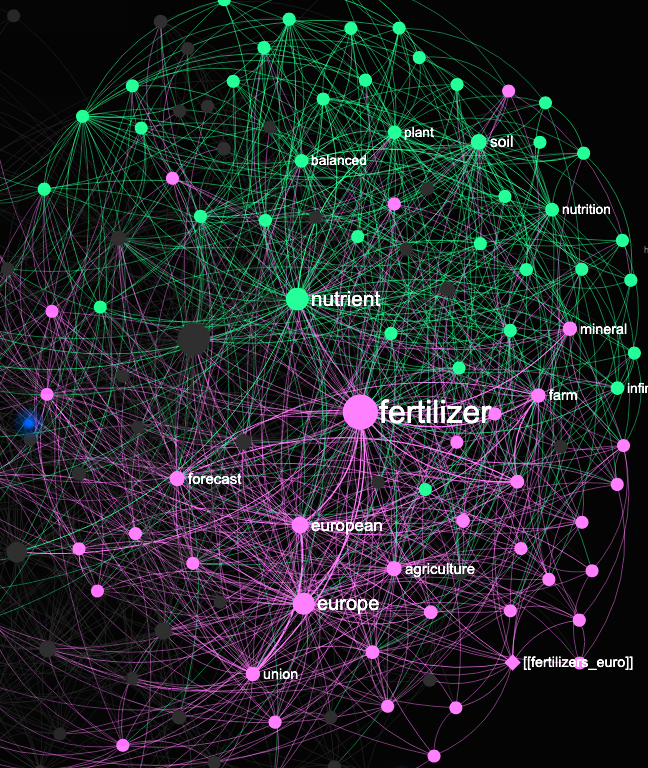
Knowledge graph visualization for this blog was generated using InfraNodus, which mapped thematic clusters such as ”fertilizer”, ”nutrient”, ”agriculture”, and ”regulation” from EU forecast reports.
Fertilizers have long been essential for European agriculture, ensuring high yields and supporting food security. However, recent forecasts from Fertilizers Europe predict a steady decline in fertilizer use across the European Union (EU). This shift is influenced by evolving environmental policies, market conditions, and agricultural practices. Analyzing the Forecast of Food, Farming, and Fertilizer Use in the European Union reports from 2017 to 2031 reveals the multiple drivers behind this downward trend.
Projected Decrease in Fertilizer Use
According to the 2021–2031 forecast, fertilizer use in the EU is expected to decline significantly by 2031, with nitrogen decreasing by 5.7%, phosphate by 3.9%, and potash by 1.4% (Fertilizers Europe, 2021). Nitrogen, which is critical for plant growth, faces the steepest drop due to environmental concerns. This continues the trend seen in earlier forecasts, where nitrogen use was already projected to decline by 3% between 2019 and 2029 (Fertilizers Europe, 2019).
Environmental Regulations and Policy Pressures
The primary factor driving this reduction is the tightening of environmental regulations across the EU. Fertilizers Europe notes that the EU’s political priorities — focusing on water quality, air pollution reduction, and climate change — directly challenge the farming sector and fertilizer use. The implementation of the Fertilizing Products Regulation (FPR) in 2022 adds complexity by introducing stricter certification requirements and emphasizing recycled and circular materials in fertilizer production. This change encourages farmers to shift away from synthetic mineral fertilizers toward sustainable alternatives (Fertilizers Europe, 2021).
Changing Cropping Patterns and Land Use
The decline is also linked to changing farming practices. The forecasts reveal a consistent reduction in cereal cultivation areas — down by 1% by 2031 — coupled with stagnating or modest yield increases. Crop diversification, including more land allocated to biogas maize and less intensive crops, further reduces the need for heavy fertilizer use. This shift is particularly pronounced in Western Europe, where more environmentally conscious policies are applied (Fertilizers Europe, 2021).
Regional Disparities Across Europe
Western European countries, including Belgium, France, Austria, and Italy, are expected to lead in nitrogen reduction with an average decrease of 8.3%. In contrast, Central and Eastern European (EU-13) countries may see slight increases in fertilizer consumption due to economic growth and less stringent environmental policies (Fertilizers Europe, 2021). This east-west divide highlights different policy applications and agricultural priorities within the EU.
Economic Pressures and Market Volatility
Europe’s fertilizer market is also impacted by economic factors. Commodity price volatility and geopolitical factors, such as the Russian embargo, have pressured farmers to reduce input costs. Fertilizer, being one of the costliest inputs, is often the first to be reduced when margins tighten. Farmers are also responding to sustainability incentives that reward lower fertilizer use (Fertilizers Europe, 2019).
The Rise of Circular Economy and Recycling Initiatives
European fertilizer use is increasingly influenced by circular economy strategies. The new FPR supports the use of recycled materials, including waste-based ammonium sulfate and biodegradable products. This policy direction reduces dependency on virgin mineral fertilizers and encourages innovation in controlled-release and sustainable fertilizers (Fertilizers Europe, 2021).
Conclusion
The decline in fertilizer use across Europe reflects a broader transition toward sustainable agriculture, driven by policy, environmental, and market forces. While this presents challenges for traditional farming systems, it also opens new opportunities for innovation in nutrient management and soil health. Europe’s focus on environmental sustainability, coupled with circular economy initiatives, is reshaping the fertilizer landscape and supporting long-term agricultural resilience.
References
- Fertilizers Europe. (2021). Forecast of Food, Farming and Fertilizer Use in the European Union 2021-2031.
- Fertilizers Europe. (2019). Forecast of Food, Farming and Fertilizer Use in the European Union 2019-2029.
- Fertilizers Europe. (2017). Forecast of Food, Farming and Fertilizer Use in the European Union 2017-2027.
- Paranyushkin, D., Liu, L., & White, R. (2019). InfraNodus: Generating Insight Using Text Network Analysis. The World Wide Web Conference, 3584–3589. https://doi.org/10.1145/3308558.3314123.